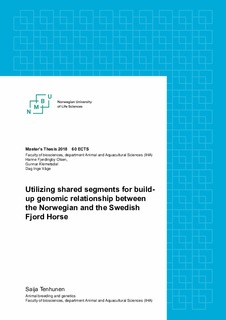| dc.contributor.advisor | Olsen, Hanne Fjerdingby | |
| dc.contributor.advisor | Klemetsdal, Gunnar | |
| dc.contributor.advisor | Våge, Dag Inge | |
| dc.contributor.author | Tenhunen, Saija Riitta | |
| dc.coverage.spatial | Scandinavia | nb_NO |
| dc.date.accessioned | 2018-11-01T13:06:54Z | |
| dc.date.available | 2018-11-01T13:06:54Z | |
| dc.date.issued | 2018 | |
| dc.identifier.uri | http://hdl.handle.net/11250/2570640 | |
| dc.description | How to generate molecular relationships from relatively small number of samples from Norwegian and Swedish Fjord Horses. These relationship methods were tested statistically and used to calculate effective population size from increase of inbreeding and coancestry per generation. Effective population size was calculated to see which relationship method gave values with smallest confidence interval and how similar these values were compared to values calculated from pedigree data. | nb_NO |
| dc.description.abstract | Challenges in conservation of native breeds, like the Norwegian Fjord Horse, require an evaluation of the relationship between animals in different countries. Traditionally pedigree data have been used to calculate relationships between animals, but pedigree information is not comparable in most cases between different countries or breeding organizations. Methods based on genomic relationships are therefore a good option. In this study we looked at 413 samples from Fjord Horses, of which 311 were Norwegian and 102 were Swedish. Individual inbreeding and coancestry were evaluated based on pedigree (PED), molecular homozygosity (HOM) and individual runs of homozygosity (ROH) or shared genomic segments (SEG) between two horses. Effective population size (Ne) was calculated from the increase of inbreeding (ΔF) or coancestry (Δf) in a generation. These methods were tested with 13 different SNP densities from 485,918 SNPs to 33,420 SNPs. With Fjord Horses pedigrees are well known and the complete generation equivalent for Norwegian genotyped horses was 13.7 and for Swedish genotyped horses was 12.4. For the Norwegian genotyped horses average PED inbreeding was 0.077 and coancestry was 0.082, and for the Swedish PED inbreeding was on average 0.052 and coancestry was 0.065. HOM methods were stable when SNP density was thinned but these were not of the same scale as PED and ROH inbreeding or SEG coancestry. ROH and SEG methods to calculate inbreeding and coancestry performed best when regressed on PED. When SNP densities were thinned down below 65k SNPs ROH and SEG methods decreased significantly and gave inaccurate estimates for inbreeding and coancestry. With ROH and SEG, small segment sizes (100kb and 500kb) detected more inbreeding and coancestry than medium segment sizes (1.5 Mb and 2 Mb). A large segment size of 5 Mb underperformed in all calculations and was ruled out. Ne calculated from PED ΔF for Norwegian horses was 71 and for Swedish Ne was 269. When calculating Ne from ΔF, ROH and HOM methods gave similar values for Ne as what was gained from PED with Norwegian horses. Results were unreliable for Swedish horses due to the low number of genotyped horses in the timeline. Ne based on ΔF was tested with three different timelines; pairs born per year, pairs born in two years and pairs born in same ten-year cohort. With HOM coancestry there was a low variation in results which lead to a shallow regression slope and therefore higher values for Ne with more standard error than Ne from SEG. Ne from SEG, when used ten-year cohort timeline, was 63 and was close to PED Ne. Ne SEG had the lowest standard error and most narrow confidence interval as compared to molecular methods used to calculate Ne. When using methods like optimal contribution selection, SEG could be the more beneficial method based on our results and previous research. This needs to be studied more deeply with horse populations where breeding schemes are very different than in commercial livestock breeding. | nb_NO |
| dc.language.iso | eng | nb_NO |
| dc.publisher | Norwegian University of Life Sciences, Ås | nb_NO |
| dc.rights | Attribution-NonCommercial-NoDerivatives 4.0 Internasjonal | * |
| dc.rights.uri | http://creativecommons.org/licenses/by-nc-nd/4.0/deed.no | * |
| dc.subject | Fjord Horse | nb_NO |
| dc.subject | Effective population size | nb_NO |
| dc.subject | SNP | nb_NO |
| dc.subject | Inbreeding | nb_NO |
| dc.subject | Molecular homozygosity | nb_NO |
| dc.title | Utilizing shared segments for build-up genomic relationship between the Norwegian and the Swedish Fjord Horse | nb_NO |
| dc.type | Master thesis | nb_NO |
| dc.description.version | submittedVersion | nb_NO |
| dc.subject.nsi | VDP::Agriculture and fishery disciplines: 900::Agriculture disciplines: 910::Livestock breeding, rearing, reproduction: 912 | nb_NO |
| dc.source.pagenumber | 32 | nb_NO |
| dc.description.localcode | M-ABG | nb_NO |

